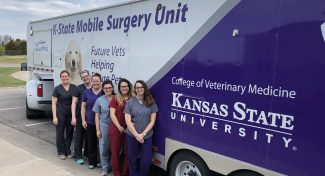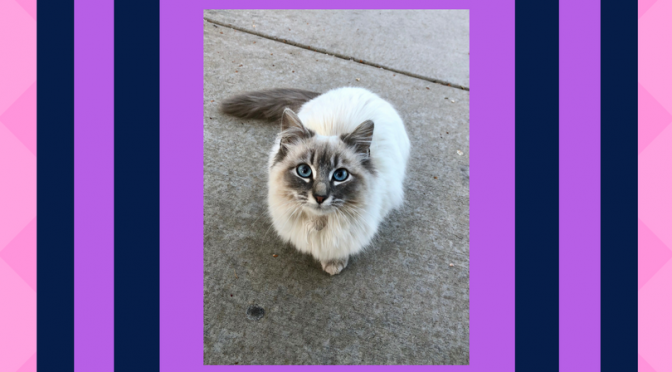Last weekend, the friendly cats of Newman were collected, borrowed, spayed and neutered, then safely returned to their campus home on Monday.
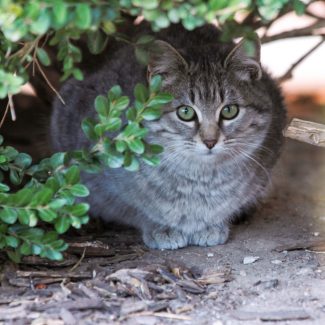
“For over a year, several people have discussed how we can responsibly care for ‘our’ cats,” Associate Vice President for Academic Affairs Rosemary Niedens said. “An opportunity came up when a student, Alicia Camacho, referred us to the Friends of Felines group.”
Camacho, a Newman student and staff member at the Mabee Dining Center on campus, has a special love for the campus felines.
Every morning when she goes to work at 6:30, Camacho sees them outside the door, where Campus Security has a food dish and water bowl for them. It took some time, but eventually several of the cats started allowing her to pet them and even hold them, she said.
“I immediately fell in love,” Camacho said. “I lost my own cat in October of 2017 when she was hit by a car and killed, so being able to go to work, interact, feed and love on the cats brought a lot of joy to my heart. It really helped me heal from the loss of my own cat.
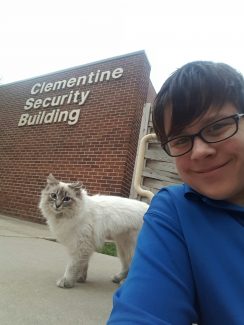
“We really enjoy and love having the cats around, but we know that if they continue to mate and become pregnant we may not be able to have the cats on campus any longer,” she said.
After discussing this concern with Niedens and Director of Security Morris “Mo” Floyd, the three decided to make some calls.
“I reached out to a friend of mine who works at Wichita Animal Action League, an organization that rescues abandoned, neglected and abused cats,” Camacho said. “She told me about the Friends of Feline program and suggested I contact them for help with getting the campus cats spayed and neutered.
“So many people love and enjoy seeing the cats on campus,” she added. “It would be heartbreaking if we weren’t able to keep them any longer because of mating and becoming overrun with them.”
Niedens and Floyd started a collection and asked for contributions from those they knew were interested in the cats’ welfare. It did not take long to reach the funds needed to get the cats spayed and neutered, so on Friday, April 27, the process of “borrowing” the beloved Newman cats officially began.
To prepare the cats for their procedures, Niedens sent out a campus-wide email to request that students, faculty and staff do not feed the cats at all on Friday evening. She also ensured that “the cats will be treated gently at all times, as the Friends of Felines group helps with cats in this way on a regular basis.”

Camacho said, “They thought it would be a good idea for someone who knows the cats and is trusted by them to be present at the time of the borrowing, in order to prevent as much stress as possible, so I agreed.”
At Saturday’s crack of dawn, Camacho met with Deb Shevlin — an elementary teacher in Wichita who volunteers with Friends of Felines — to help set the humane traps that would collect the cats for their surgeries the next day.
“The whole process is incredible,” Shevlin said. “We usually put a drop trap out and do that for at least a couple days beforehand to ‘trap train’ the cats. The caretaker feeds under the trap throughout those days so that then when the volunteers come to collect the cats, it’s pretty simple. With the drop trap we can catch several cats at a time, and after they are caught we put a light sheet over them to reduce stress.”
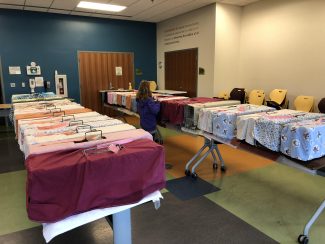
Shevlin’s passion for cats has led her to not only volunteer but also to build an enclosure and house a few pets of her own.
She added, “This is a hard life for cats, and you are making sure that other cats aren’t subject to it and that they aren’t going to be destroyed. (This process) helps them live and be healthier, too.”
“If we discover that a cat is nursing, then that cat will go home as soon as she is stable and wide awake so that she can tend to her kittens,” Cheryl Taskinen, president of Friends of Felines, said.
If a cat is nursing and the kittens are too young to survive without their mother to feed them, however, they are not taken to be spayed until the kittens are old enough to sustain themselves.
After the cats are moved into live traps one at a time, they are then taken to a holding garage to be fed and kept clean. The next day, the cats are transported to the Kansas Humane Society (KHS), where staff uses a learning center room to set up for the surgeries.
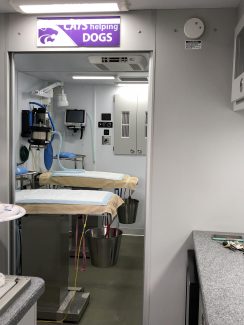
The K-State Shelter Medicine Mobile Surgery Unit parks directly outside a door at the KHS so cats can easily be carried from place to place. The team of fourth-year veterinary students then complete the procedures using the four surgery stations within.
The K-State mobile team travels up to two hours from Manhattan, Kansas, to animal shelters multiple times every week in order to provide spay and neuter services for dogs and cats being placed for adoption. The mobile unit allows for fourth-year veterinary students to spend two weeks strengthening surgical skills, learning about shelter medicine, population management and animal welfare.
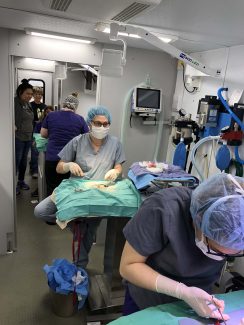
“The impact of this program on students is incredible,” Dr. Alyssa Comroe, clinical assistant professor of shelter medicine at K-State, said. “Not only do they have the opportunity to refine surgical skills, but they get to see firsthand what a difference they can make for homeless animals as veterinarians in their own communities one day.”
Following surgery, K-State uses a reversal drug on every cat so they wake up from the anesthesia quicker and better, Taskinen said.
“If the cats are thrashing around, we put a little fan on them to help cool them down because otherwise they can overheat and go into a coma,” Shevlin said. “And for the next 24 hours following surgery, the cats can’t control their body temperature, so we have to be careful where they are. We’re aware of the temperature and want to make them comfortable.”
Along with surgery, the cats are given their rabies vaccinations and are “ear-tipped.”
“Ear-tipping is a painless process where the left side of the ear is clipped,” Shevlin said. “Since they are feral cats, this is helpful because it tells us at a distance that this particular cat has been spayed or neutered.”
Spay and neuter surgeries make up a large portion of a shelter’s operating expense, so there are several benefits to providing these surgeries at no cost to shelters, Comroe said.
“It allows them to spend those funds on more advanced veterinary treatment and procedures for animals that would not otherwise receive them, or for other programs to help their life-saving missions,” she said. “Our goal is to create more practice-ready shelter veterinarians and to create veterinarians who are compassionate to the plight of homeless animals in their communities.”
Niedens added, “They have been great to work with, coordinating with the K-State vet school. You could really tell they like cats as they treated the cats gently throughout the entire process.”
